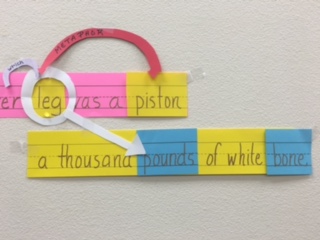Level 1: Then Jody stood and watched the pony, and he saw things he had never noticed about any other horse.
*Note that Steinbeck explains what kind of things with a simple sentence/clause.
I think the point here for depth is that clauses inside of sentences can be tools for writers to add depth through explanation and examples. The clause explains HOW one adds the explanation.
*the prepositional phrase adds depth here by explaining which one - comparing the red pony to all the other horses.
Writers need to know that prepositional phrases are forms of adding depth through description. Prepositional phrases used like this one also help the reader to make connections and distinctions to and between other ideas.
In this level, I highlighted "things he never noticed" because Level 2 modifies this phrase. Everything in level 2 gives depth and explanation to this phrase. Notice that the sentence continues, and creates a kind of list of what Jody notices.
*Here, the phrases form a kind of list that give examples of the things that Jody notices.
Here's the text again in case you can't see the picture well:
Level 2: the sleek, sliding flank muscles and the cords of the buttocks, which flexed like a closing fist, and the shine the sun put on the red coat.
In Level 1, I highlighted "things he never noticed" because Level 2 modifies this phrase.
Everything in level 2 gives depth and explanation to this phrase.
(Not sure what is happening with the alignment of the text here. But who really cares? Just ignore the centered text. Ain't nobody got time for wigged out technology.)
I didn't take a picture of it, but notice the simile "like a closing fist" that gives an example of the verb "flexed." This gives the reader an image of how the cords on the buttocks look. The simile is used to add depth! Craft = depth.
Back to Level 2 and Level 3.
Noden classifies the next sequence like this:
Level 1: Having seen horses all his life, Jody had never looked at them very closely before.
Level 2: But now he noticed the moving ears which gave expression and even inflection of expression to the face.
Level 2: The pony talked with his ears.
Level 2: You could tell exactly how he felt about everything by the way his ears pointed.
Level 2: But now he noticed the moving ears which gave expression and even inflection of expression to the face.
Level 2: The pony talked with his ears.
Level 2: You could tell exactly how he felt about everything by the way his ears pointed.
*All of the Level two additions zoom into the way Jody looks at the horse. They all show the examples of the close examination.
The first Level 2 example shows how Jody's examination focuses on what the pony's ears are doing in terms of expression and inflection. The second Level 2 example is a restatement of the first sentence. Steinbeck names what the expression and inflection are doing for the pony through personification! Yet another literary device used to create depth. The last Level 2 modifier explains how Jody interprets what he sees.
In thinking about how I would name, or list, the strategies of depth here, I'd create a chart that had these items: lists and examples, actions/movement, restatement, personification, interpretation. These are all explicit craft moves that a writer can make in creating depth.
Examining Level 3:
Here's how Noden classified the sentences:
Level 2: You could tell exactly how he felt about everything by the way his ears pointed.
Level 3: Sometimes they were stiff and uptight and sometimes lax and sagging.
Level 3: They went back when he was angry or fearful, and forward when he was anxious and curious and pleased; and their exact position indicated which emotion he had.
Level 3: Sometimes they were stiff and uptight and sometimes lax and sagging.
Level 3: They went back when he was angry or fearful, and forward when he was anxious and curious and pleased; and their exact position indicated which emotion he had.
*All of the previous Level 2 sentences focused on the ears. The Level 3 examples again form a kind of list with specific examples that illustrate different scenarios.
The first Level 3 examples "stiff and uptight" and "lax and sagging" describe which direction the ears are pointing. The second Level 3 description gives specific scenarios of the directions the ears move and the way Jody interprets them.
Listing the moves a writer would make to create depth: imagine scenarios, give interpretations, use adjectives, use terms for direction and emotion.
In fact, that's something that I like about all of this visual examination. We have a real reason to use the grammar terms: all in context of why we have the terms in the first place! Grammar terms only exist because we need words to talk about what our writing is doing to the reader. (Kind of a Rosenblatt grammarian connection here, I guess. If you get this reference, you are definitely my kind of Reading geek. You probably like Vygotsky too.)
































